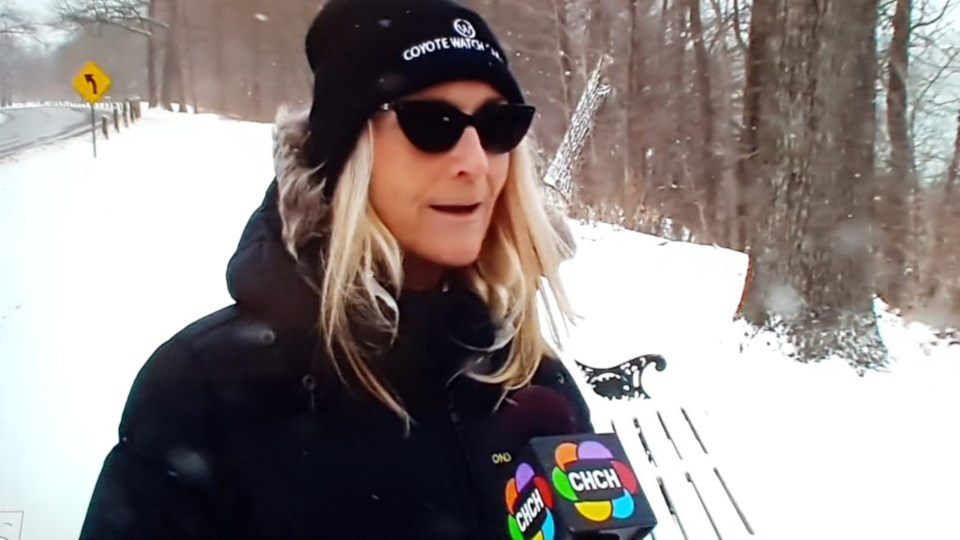
Lesley Sampson, founder and executive director of Coyote Watch Canada, has made a career of educating people about coyotes.
She’s no stranger to Niagara-on-the-Lake, where she began studying coyotes more than 20 years ago. Her research and continued efforts in town have been mostly directed toward educating residents concerned about sightings of coyotes in urban areas.
Her visit to NOTL last week, however, was quite different — one she found deeply disturbing. She had come to investigate the dumping of several dead coyotes on the steep slope of the gorge along the Niagara River.
Since The Local had received a report from a fisherman on his way home from Queenston, a heavy snowfall had covered the area, making it impossible for her to see the coyotes herself. She had only photos to go on, and no way to determine how they were killed or why they were dumped. But her guess, she says, is they were a “thrill kill.” She also used the term “slob hunters,” both derogatory terms for hunters who kill for excitement or gratification.
“This is not the behaviour of ethical hunters,” says Sampson. “This is the epitome of what conservation is not about. These people have no regard for anyone or anything.”
It’s been going on for decades, and not only in NOTL, but the deep slope down to the Niagara River, she says, is an easy and convenient place for disposing of the animals.
“Who is going to see them? The region is a hot spot for out-of-town hunters. I’ve seen several different dumping spots in NOTL,” she says, including on private property.
She’s been called by homeowners who have had issues with hunters on their property, including one senior who was afraid to walk on her own property for fear of being shot by accident. And she’s photographed dead coyotes, left by hunters, on public and private property.
If there is a message from this “horrifying” situation, Sampson says, it is for people to be aware and on the lookout for this illegal dumping of coyotes, which is just one part of a much larger issue — the unethical, wanton, en masse slaughter that leads to the dumping.
In this case, Sampson says, it’s not one pack of animals that has been killed, it’s happened over a period of time.
Niagara Parks Commission Police Chief Paul Forcier says he’s had reports before about the coyotes, going back to last spring, and an officer dispatched counted eight. Coyotes are spread out in a few different locations, all on the slope down to the gorge, he says. It was determined it would be dangerous to try to remove them, and since they are not in an area accessible or even likely to be seen by the public, it was decided to leave them where they are.
“We’re not going to put anyone at risk to retrieve them,” said Forcier. “We’re troubled by it. Nobody likes to see animals dumped in that manner, and it’s unfortunate it’s occurred.”
If an animal could be picked up safely they would do that, “but that’s clearly not the case.”
It’s possible they were “dispatched to protect livestock,” and they have been dumped on more than one occasion, according to reports, he says, but although they’ve received complaints, nobody has come forward to say they’ve witnessed the activity or reported a vehicle or licence plate number, making it impractical to investigate.
It would be easy for someone to witness something and not realize what they’re seeing, says Sampson.
Parked by the Niagara River Recreation Trail Friday, at the spot where the coyotes were photographed last week, Sampson and The Local photographer Fred Mercnik, an animal lover who was devastated by the cruelty he had witnessed, were interviewed by CHCH. It is a place trucks and cars pull over, Sampson says, and nobody would think anything of it.
“Maybe people will be more aware now, and decide to report it. If someone sees something, they need to call the parks police, or maybe engage the Ministry of Natural Resources.”
Both the parks police and the ministry are investigating, says a representative of the Ministry of Natural Resources and Wildlife.
“There are a whole bunch of agencies that would work together, and if we (Coyote Watch) could help in any way, we would, gladly,” says Sampson. “We’re often the conduit between government agencies and the public.”
If someone sees something and doesn’t make the call, “this is going nowhere,” she says. “We’re trying to create awareness, so this never happens again.”